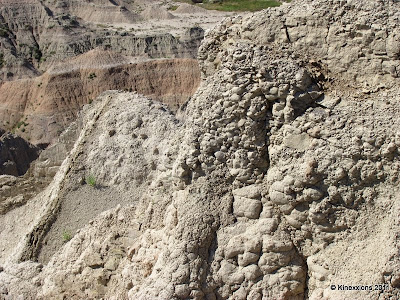
A little while back, someone suggested that I read Bill Strickland's Ten Points, and before I knew it I was interacting with Bill Strickland himself and he sent me a copy. When the book arrived, the cover alone induced a pre-emptive sense of nostalgia. A cyclist walking his bike into the fading sun, beneath the overhanging trees, as if savouring the sweet devastation of defeat. Of course this would be on the cover of Bill Strickland's memoir.
Bill Strickland is the editor of
Bicycling Magazine. He lives in Pennsylvania. He races for Kapelmuur Independent. And he writes, a lot. Articles for various cycling and sometimes non-cycling magazines, a few books, blog posts. The first time I read something by him was maybe in
Rouleur a year ago, and then I began following him online. I remember it initially surprised me that a person who wrote like Bill Strickland was the editor of
Bicycling. Those guys are all about nutrition and training and race coverage and roadbike reviews. Strickland's writing is evocative and sensual and self-consciously sentimental. And that's just on his instagram account.
Ten Points is an unconventional memoir. It's inextricably tied to bicycle racing, but is not really about it. Bicycling is more of a metaphor, an explanation, a case study in magical thinking. At the start of the book, the author tells his little daughter that he will score 10 points during a single racing season, then proceeds to participate in criterium races and fail spectacularly week after week.
But this plot line merely serves as a trajectory for the real story - a story of surviving childhood abuse, emerging damaged, then wondering for the rest of your life whether you're human or a piece of garbage. In adulthood, the author considers himself cursed, a monster. He struggles to stay in control, but the past haunts him and he worries about being a fit parent and husband. He believes that cycling keeps the monster in him at bay. And winning 10 points for his daughter might just have the power to lift the curse entirely.
Reading the memoir and trying to process it as such, I must admit that I found the 10 points theme to be overbearing and at times distracting. The writing is good. Bill Strickland excels at creating a visceral sense of understanding between himself and the reader. Repeatedly I found myself lost in his past, in his life, in his very sensations. In contrast to this, the overarching storyline of the 10 points feels forced, packaged. Like maybe the author had written the book differently, and then some editor swooped in and tried to make it more marketable for those who like the "top 10 ways to tackle hills" types of articles. I don't know how else to explain it.
Could the story have been told without the 10 points theme being so overt? I honestly think that it could. The book is really a rich collection of snippets, flashbacks to various incidents in the writer's life, and there are other ways in which these could have been tied together. The narrative style is jewel-like, seductive, while somehow also managing to come across as sparse and reserved. It is part American Gothic, part John Updike, but replete with its own, uniquely Stricklandian, characteristics.
In a way
Ten Points reads more like a novel than a memoir, and some characters feel more believable than others. The incidents from the past, despite how dramatic some of them are, read as believable, as do the parts about racing. But in the present-day dialogue with the wife and daughter, the things they say are sometimes too well-phrased, too conveniently meaningful. In those instances I could practically feel the author trying to wrangle them into the 10 points plot.
At his best, Bill Strickland is the sort of natural storyteller who can engage an audience with a description of an Idaho cornfield. He can stir the reader into alternating states of wistfulness and fear within a single paragraph. He is a master of subtle foreshadowing. I want more of all that, less meta-narrative.
Writing about this book, I find myself wishing I hadn't interacted with the author prior. Because now I am hyper-aware of him as a real person and nervous about how he will feel reading this. But maybe that's arrogant. After all, who the heck am I and what does it matter what I think. I am describing the book as a reader, not as a critic. And I continue to follow Bill Strickland's writing with interest.
 Two years ago today, I wrote my first blog post, which was no masterpiece by any stretch of the imagination, but it was a beginning. So, now, can I say I'm one of the Old Timers?
Two years ago today, I wrote my first blog post, which was no masterpiece by any stretch of the imagination, but it was a beginning. So, now, can I say I'm one of the Old Timers?

 I don't know about you climbers,but the idea of pointing some welding rod thingy, that's seething with a high potential electric charge at a pipe that's pressurised with natural gas in the middle of a populated city,as a little spooky.
I don't know about you climbers,but the idea of pointing some welding rod thingy, that's seething with a high potential electric charge at a pipe that's pressurised with natural gas in the middle of a populated city,as a little spooky.





 You are probably getting tired of seeing reflections of the sky in the water, but I just can't help myself! I am captivated by them... a narrow view between the trees.
You are probably getting tired of seeing reflections of the sky in the water, but I just can't help myself! I am captivated by them... a narrow view between the trees. Even with the sunshine, there occasionally were a few scattered showers.
Even with the sunshine, there occasionally were a few scattered showers. I took several shots of the pavement but it just doesn't show what it was really like. See those yellow flags alongside the road? Those indicate dips in the highway. So while you are jostled from side to side with the uneven pavement, when you reach the dips you are also bouncing up and down. Throw in a few potholes and several really bad sections for a challenging ride! I was so happy to get through it unscathed.
I took several shots of the pavement but it just doesn't show what it was really like. See those yellow flags alongside the road? Those indicate dips in the highway. So while you are jostled from side to side with the uneven pavement, when you reach the dips you are also bouncing up and down. Throw in a few potholes and several really bad sections for a challenging ride! I was so happy to get through it unscathed. The view from my campsite, looking south. Gorgeous. Forty-six miles long, Lake Kluane is the largest lake in Yukon Territory and the highway follows it on the west side for about half of its length.
The view from my campsite, looking south. Gorgeous. Forty-six miles long, Lake Kluane is the largest lake in Yukon Territory and the highway follows it on the west side for about half of its length. A closeup of the mountains on the south side of the lake.
A closeup of the mountains on the south side of the lake. From the bridge on the west side of the south end. This is actually a river that feeds the glacial water into the lake.
From the bridge on the west side of the south end. This is actually a river that feeds the glacial water into the lake. Looking east. A narrow peninsula juts out from the western side of the lake.
Looking east. A narrow peninsula juts out from the western side of the lake. The highway is at the base of that mountain, following the shoreline. Ten miles north of that point is the Cottonwood Campground.
The highway is at the base of that mountain, following the shoreline. Ten miles north of that point is the Cottonwood Campground.
 It's been 3 weeks since I've been in the park... Thankfully, some of the climbing rangers have been helping w/ route and condition updates. That said, we still love your climbing reports. Over the next day or two, I'll upload many of the great reports climbers have been sending.
It's been 3 weeks since I've been in the park... Thankfully, some of the climbing rangers have been helping w/ route and condition updates. That said, we still love your climbing reports. Over the next day or two, I'll upload many of the great reports climbers have been sending. 
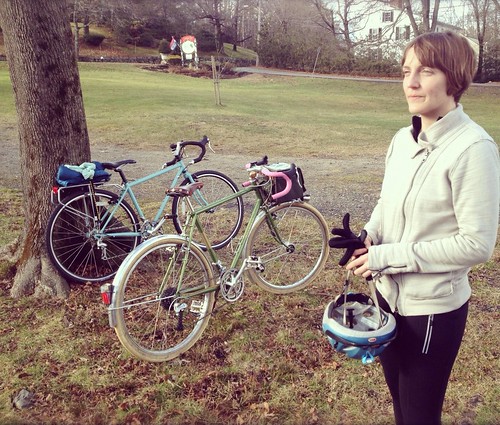 My last ride of was with the delightful Bekka ofBikeyface, who is slowly but surely getting drawn into roadcycling (eeexcellent). We've been practicing our "epic" faces, as you can see.
My last ride of was with the delightful Bekka ofBikeyface, who is slowly but surely getting drawn into roadcycling (eeexcellent). We've been practicing our "epic" faces, as you can see.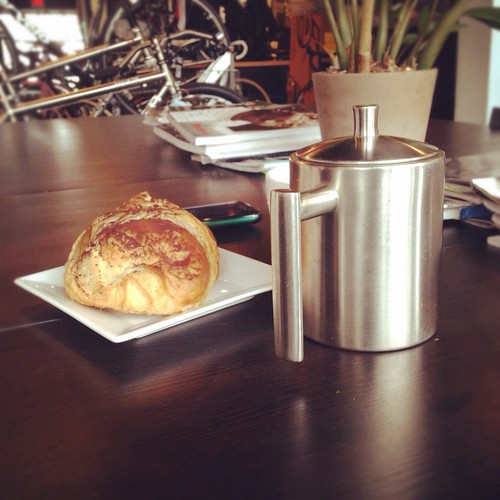 We had some things to talk about, so we decided to "go for coffee" - a 20 mile ride to the Ride Studio Cafe and back.
We had some things to talk about, so we decided to "go for coffee" - a 20 mile ride to the Ride Studio Cafe and back.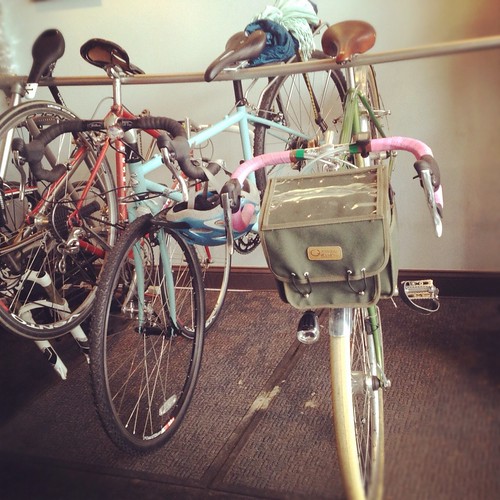 Once there, we nearly took the rack down with 60lb of collective bike poundage, but never mind!
Once there, we nearly took the rack down with 60lb of collective bike poundage, but never mind! The weird thing about riding with Bekka, is that her bicycle - a Surly Cross-Check - is the same make and model as the Co-Habitant's bike - only about half the size and built up very differently. The smaller sized Cross-Check frames have sloping top tubes and different seat tube angles(75° on the 42cm frame vs 72° on the 62mm frame), so altogether her bicycle registers as sort of the same bike as his, but not really. Freaky. And it also goes to show that when reading bicycle reviews and test ride reports, it's worth paying attention to the size of the bike described - this factor can make a difference. But despite the blatant differences in frames, both Bekka and the Co-Habitant are quite happy with theirs, so it seems fair to conclude that the Cross-Check is a crowdpleaser.
The weird thing about riding with Bekka, is that her bicycle - a Surly Cross-Check - is the same make and model as the Co-Habitant's bike - only about half the size and built up very differently. The smaller sized Cross-Check frames have sloping top tubes and different seat tube angles(75° on the 42cm frame vs 72° on the 62mm frame), so altogether her bicycle registers as sort of the same bike as his, but not really. Freaky. And it also goes to show that when reading bicycle reviews and test ride reports, it's worth paying attention to the size of the bike described - this factor can make a difference. But despite the blatant differences in frames, both Bekka and the Co-Habitant are quite happy with theirs, so it seems fair to conclude that the Cross-Check is a crowdpleaser.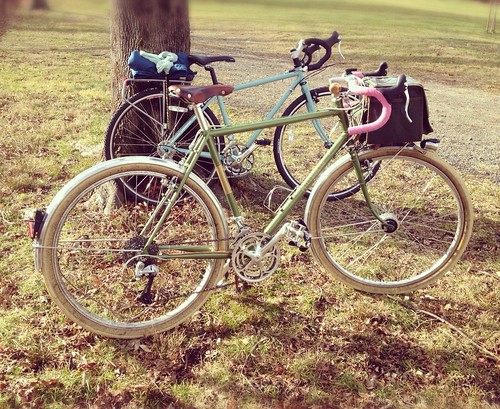 With Bekka on the Surlyand me on the Rivendell, we were pretty well matched for speed, which was nice. It was a quiet morning just before New Year and we were able to ride side by side some of the time.I used to be vehemently against cycling side by side on the road - especially in the city - because I felt that this distracted me from paying attention to traffic. Now I am less vehement about it, simply because I've ridden with people who cycle side by side as a matter of course and have learned to adapt. Still, I seldom have a good feeling about it. While in Massachusetts it is legal to ride two abreast, one could argue that doing so is not always practicable, and therefore not in good faith. It has also been known to provoke driver aggression. The local cyclists I've been riding with are split on this one, with some groups prohibiting riding two abreast and others insisting on it, so I am getting some rather mixed messages. I'd like to decide on a policy and stick with it without being influenced by the people I am riding with, but haven't made up my mind yet.
With Bekka on the Surlyand me on the Rivendell, we were pretty well matched for speed, which was nice. It was a quiet morning just before New Year and we were able to ride side by side some of the time.I used to be vehemently against cycling side by side on the road - especially in the city - because I felt that this distracted me from paying attention to traffic. Now I am less vehement about it, simply because I've ridden with people who cycle side by side as a matter of course and have learned to adapt. Still, I seldom have a good feeling about it. While in Massachusetts it is legal to ride two abreast, one could argue that doing so is not always practicable, and therefore not in good faith. It has also been known to provoke driver aggression. The local cyclists I've been riding with are split on this one, with some groups prohibiting riding two abreast and others insisting on it, so I am getting some rather mixed messages. I'd like to decide on a policy and stick with it without being influenced by the people I am riding with, but haven't made up my mind yet. Switching from "lone wolf" cycling to riding with others has caused a rather dramatic upheaval in my little world.I had tried the social cycling thing before and did not enjoy it, but somehow this time around it clicked. Suddenly I have a full "dance card" of cycling events every week, and in the winter at that. Not that I am complaining! But this is definitely a new era, and I am curious what the future will bring.
Switching from "lone wolf" cycling to riding with others has caused a rather dramatic upheaval in my little world.I had tried the social cycling thing before and did not enjoy it, but somehow this time around it clicked. Suddenly I have a full "dance card" of cycling events every week, and in the winter at that. Not that I am complaining! But this is definitely a new era, and I am curious what the future will bring.
 Visitors have been commenting on the haze and smoke in the air; climbers have noticed it too. The
Visitors have been commenting on the haze and smoke in the air; climbers have noticed it too. The  Now that H Street is coming back into its own, I wanted to pick my father’s brain about what it was like back in his day, in the 1920s. I decided we ought to take a tour, and see what was left, so we climbed into my pollen laden car and went back in time.
Now that H Street is coming back into its own, I wanted to pick my father’s brain about what it was like back in his day, in the 1920s. I decided we ought to take a tour, and see what was left, so we climbed into my pollen laden car and went back in time. e and the Princess - all of them gone now. (The Atlas which is now a performing arts center
e and the Princess - all of them gone now. (The Atlas which is now a performing arts center We nabbed a mail person and continued down memory lane.
We nabbed a mail person and continued down memory lane. It's a challenge trying to compose Mt. Rainier-specific prose given the recent terrible news about Lara Kellogg
It's a challenge trying to compose Mt. Rainier-specific prose given the recent terrible news about Lara Kellogg










